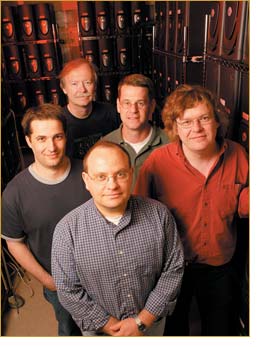
One of the World’s
Fastest Computers The Bunch-o-Boxes cluster is one of 24 of the top 500 supercomputing
clusters which are “self-made,” designed and assembled
by the end users. It ranks approximately 42nd out of all supercomputing
systems at U.S. academic institutions. The Bunch-o-Boxes cluster is one of 24 of the top 500 supercomputing
clusters which are “self-made,” designed and assembled
by the end users. It ranks approximately 42nd out of all supercomputing
systems at U.S. academic institutions.The Bunch-o-Boxes (B.O.B.) Laboratory is a 106 dual-processor Beowulf cluster located in the Stepan Chemistry Hall and administered by the Science Computing Facility. According to a list of the top supercomputing sites which was published in June 2003, the B.O.B. lab is one of the top 500 clusters in the world. Designed and built by the colleges of engineering and science in order to provide high-end computing on campus for data- and time-intensive projects, the cluster was funded through a grant from the National Science Foundation’s Major Research Initiative program. Research simulation and modeling activities in B.O.B. span a broad range of disciplines and departments throughout the University. Experiments currently under way include projects in nanomaterials and complex fluids, directed by Edward J. Maginn, associate professor of chemical and biomolecular engineering, as well as projects in global optimization, interval analysis, and environmentally conscious process design, which are led by Mark A. Stadtherr, professor of chemical and biomolecular engineering. Albert-László Barabási, the Emil T. Hofman Professor of Physics, directs studies in networks and granular media. J. Daniel Gezelter, assistant professor of chemistry and biochemistry, focuses on diffusion through biological membranes, glass formation in metallic alloys, theories of diffusion in liquids, and the development of methods for molecular dynamics in biomembranes. Projects in theoretical astrophysics, relativistic hydrodynamics, and stellar evolution are being directed by Grant J. Matthews, professor of physics. Olaf G. Wiest’s efforts in B.O.B. include the development of mechanisms and models of DNA photolyase, studying the structure and reactivity of hydrocarbon radical ions, and defining molecular implementations of Quantum Cellular Automata, a transistorless nanoscale approach to computing developed at Notre Dame. Wiest is an associate professor of chemistry and biochemistry. B.O.B. processes at a rate of 280 gigaflops -- 280 billion floating operations -- per second. The Earth Simulator, located in the Earth Simulator Center in Yokohama, Japan, is the world’s fastest “processor.” Performing at 35.61 teraflops -- more than 35 trillion floating operations per second, its function is to analyze global environmental problems such as tectonic activities, global warming, and unusual atmospheric phenomena. |